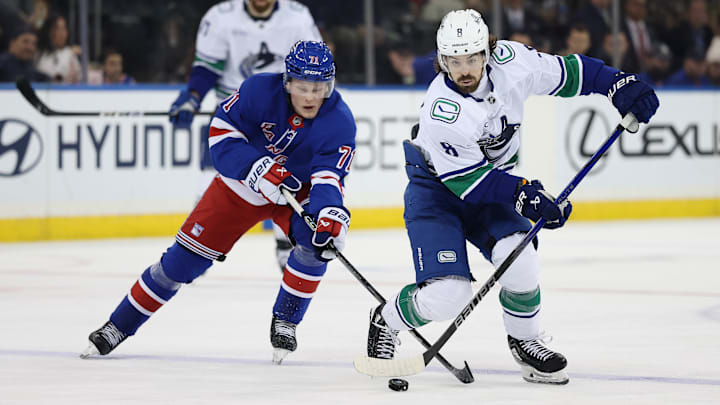
He was acquired by the New York Rangers at the NHL trade deadline, and at first, it seemed like he was simply a throw-in to help balance salaries and clear a roster spot for the Colorado Avalanche.
However, that assumption was quickly dismissed when the Blueshirts signed him to a two-year extension—a surprising decision that further complicates an already packed bottom-six forward group.
Expectations
Parssinen was considered a marginal player before joining the Rangers. Prior to that, he appeared in 22 games with the Avalanche and 15 with the Nashville Predators. While with Colorado, he tallied 2 goals and 4 assists while averaging 9:47 of ice time per game. In Nashville, he notched 2 goals and 3 assists, playing an average of 12:13 per game.

At 24 years old and a former 7th-round pick, expectations for Parssinen have always been modest, which partly explains his limited role with the Avalanche. His stint in Colorado came after a significant decline in performance with the Predators, as he never recaptured the promise he showed during his rookie campaign in 2022–23.
Performance
Parssinen suited up for 11 games with the Rangers and offensively outperformed any expectations from the coaching staff, front office, or fans. He logged an average of 9:46 per game and recorded 2 goals and 3 assists for 5 points, giving him a 0.45 points-per-game rate. That’s 18 basis points higher than his stint with Colorado and 12 points better than his time with the Predators.
From an analytics perspective, however, the results were less encouraging. Despite the limited sample size, his advanced metrics were underwhelming: a Corsi For Percentage of just 36.57, an expected goals for percentage (xGF%) of 35.6, and a goals for percentage (GF%) of 57.46.

By comparison, with the Avalanche, he posted a 67.1 GF%, a 53.47 CF%, and a 45.71 xGF%. With the Predators, those numbers were 19.87 GF%, 45.48 CF%, and 37.2 xGF%.
The discrepancy between his goals-for numbers and expected goals-for percentage with the Rangers suggests a degree of puck luck in earning his 5 points, while his low possession metrics indicate he spent more time reacting to play than driving it—something that was true in both Nashville and New York. Overall, he seems suited for a bottom-six role with the Rangers, though the front office’s decision to extend him implies they see some untapped potential. What exactly they see, though, remains a bit of a mystery.
Where They Go From Here
This grade might seem tough, but it reflects his performance with the Rangers as well as his time with the Avalanche and Predators. When you combine everything, he played 48 games, scored 16 points, and recorded a 45.08 GF%, 46.31 CF%, and 39.5 xGF%.

The Rangers already had players producing similar stats, and they trusted those players because they had invested draft picks or development time in them. Those players were also generally younger, giving them more time to improve, which is likely why the team kept them.
Parssinen was acquired through a larger trade, and the team quickly extended his contract. While he might benefit from coaching under Mike Sullivan, based on his career so far, it’s unlikely that his overall potential is significantly higher.



Be the first to comment